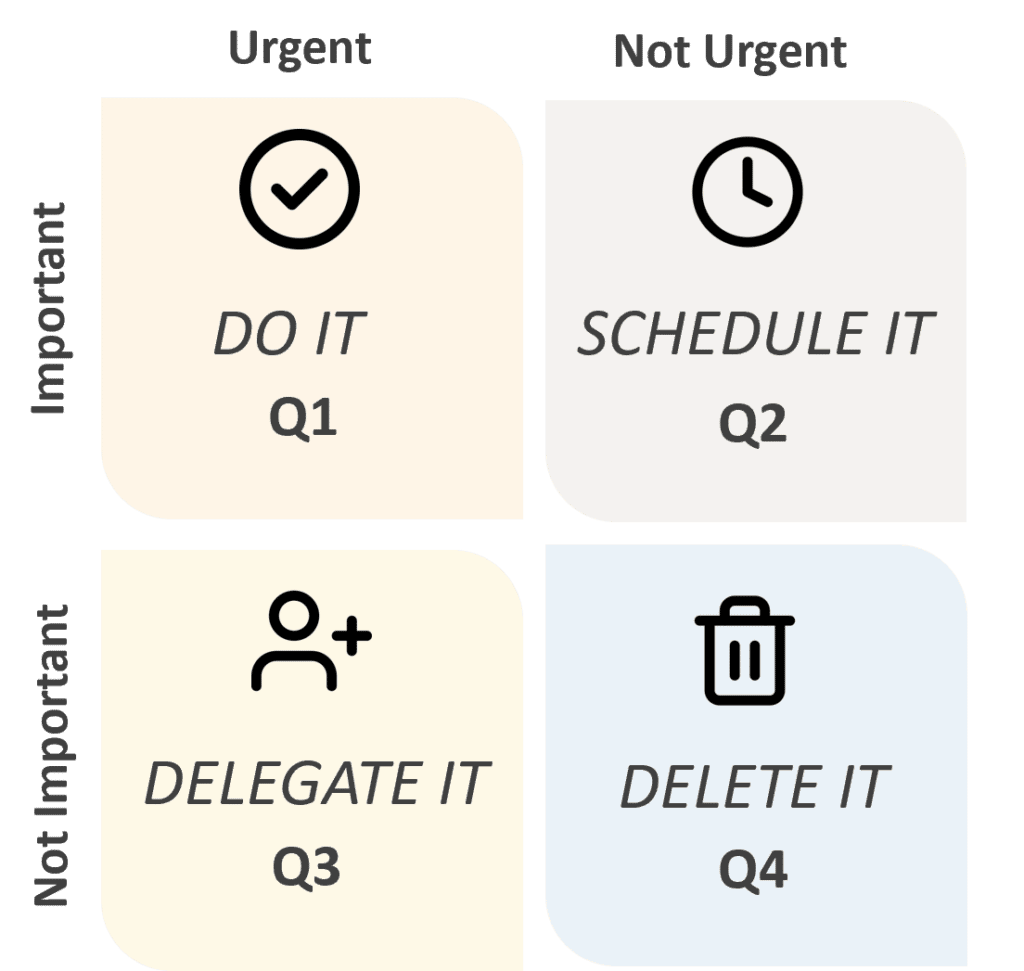What it is with time and energy.
To reenergize their workforces in times of hybrid work and productivity paranoia, organizations need to shift their focus even more away from time management to energy management.
Time is a finite resource. It is a resource that is non-renewable, so once time has passed you cannot turn it back.
What we have seen with hybrid work post-COVID-19 is that it has made us work longer hours because time at work blends fluidly with leisure time. Furthermore, MS Teams chats have increased enormously with more digital interruptions, fatigue and attempts to multitask. For office workdays, some people have also post-COVID-19 been much more sensitive to noise. If we try to focus on our tasks in the office workspace, frequent interruptions from office chattering, which can also be important for socializing, can lead to involuntary interruptions and energy drain.
Much more so than before COVID-19 lockdowns is my interpretation.
A great Harvard Business Review article from 2010 describes that doing several things at once is actually a trick we play on ourselves, it is not multitasking[1]. What really happens is that we switch-task, i.e. rapidly shift from one thing to the other, e.g. from sending quick e-mails to simultaneously focus on other tasks to online meetings[1].
The task switching interrupts us. We actually interrupt and distract ourselves[1].
Interestingly, trying to multitask leads to a 40-percent drop in our productivity, 10-percent drop in our IQ and increased stress levels[1]. So, it matters how we focus our attention, energy and time.
Another 2007 Harvard Business Review article emphasizes how very few organizations seem to help their employees build and sustain their capacity – their energy – which is typically taken for granted[2]. Today, post-COVID-19 data seems to support that. Data points to the fact that employees and managers are more stressed, fatigued and even burned out than ever before[3]. So, time and energy management can affect well-being.
What can actually fuel our capacity to work is our energy and energy management[2]. Increasing that capacity is what can help us get more done faster and better[2].
Well, let’s see what we can do to positively affect that.
As a Coach, I often work with clients who need help to better manage their time and energy. Therefore, my intention is to provide some simple tools you can use to better balance your time and energy in your leadership role as a new first-time manager. New managers will have to navigate uncertain times of change and transition, so they will need to prioritize well.
These topics can of course also be very useful for non-managers and in your life.
Next, I will share a simple focus tool with you called the Circle of Influence by Stephen Covey .
What you need to better focus your energy: Stephen Covey’s Circle of Influence.
Recently, I began re-reading the brilliant bestseller The 7 Habits of Highly Effective People by Stephen Covey. The book lays out 7 habits that can help improve your personal, team and organizational effectiveness. Here below you find and overview of the 7 habits as they are visualized in the so-called The 7 Habits Tree[4].
In this part, we will focus on Habit 1: Be Proactive® and what it actually entails.

When people are proactive they focus their time and energy and act consciously on the things they can control and influence instead of the things, which they cannot affect[5,6].
A great tool to help us better focus our energy is Stephen Covey’s Circle of Influence shown below. It can help you become more aware of and attentive to your influence and proactivity.

As you can see in the above model, it consists of an outer Circle of Concern and an inner Circle of Influence. When it comes to issues you might encounter as a new leader and in life, Stephen Covey highlighted in his book that they all fall into two different areas[6]:
- The
Circle of Concern: Everything that might affect you, your life and your business, the external things over which you have little or no control. The issues we cannot influence much such as economic crisis, inflation, energy prices, effects of war, pandemics such as COVID-19 or even the weather etc. - The
Circle of Influence: Everything you can actually control and influence. Your focus, actions, thoughts, beliefs, attitude, behavior; your company work culture, leadership style, your team’s behaviors, motivating your team, retention of team members, goal-setting, building your leadership skills, how you apply your time as a manager etc.
The thinking behind Stephen Covey’s Circle of Influence is that you have a conscious choice and responsibility for yourself, your life and leadership in this case[5,6]. So, instead of worrying about the things you cannot control (the Circle of Concern), a proactive focus is to spend your time and energy on the inner circle. These are the things that you can control and influence. It is about the freedom to choose your focus and reaction[5,6].
By being proactive, you focus on the inner circle of the model, which generates positive energy that enlarges the inner circle and positively affect your beliefs and behaviors[6]. A proactive person will typically also use more positive language, e.g. I can, I will, I do it etc.[6]
On the other hand, being reactive means to blame circumstances, conditions and things happening for your behavior[6]. Having a reactive focus makes you find external sources to blame for your behavior[6]. A reactive person will often use more reactive or negative language, e.g. I can’t, I will never do it, I have to etc.[6]
That reactive focus creates negative energy that can actually reduce the Circle of Influence. The negative energy also makes you neglect doing something about what you can influence[6]. That might prevent you from changing behaviors, assumptions and beliefs. Leadership Coaching is one opportunity, which can help you become aware of exactly that as a new manager. It creates self-awareness about how you spend your time and energy and where your focus goes.
The Circle of Influence combines well with the 3-part triad to find your mental & emotional state, which I introduced in a previous blog.
Now, we have become aware of the metaphorical spheres of control and influence and how it fits within our concerns. A proactive versus reactive focus. Lets move on to how you can better prioritize your time and energy as a new manager in your busy context of change with the Eisenhower Matrix.
Stephen Covey’s Time Management Matrix aka The Eisenhower Matrix.
The Eisenhower Matrix was originally inspired by and named after the 34th President of the United States, Dwight D. Eisenhower[7]. He served as the US President from 1953-1961. Before serving as President, he had a long and very impressive military career. Among others he served during World War I, in the Philippines and as a Supreme Commander in World War II[7].
Eisenhower rapidly advanced in the ranks during his 37 years of military service because of his impressive knowledge of military strategy, his effective organization talent as well as his social skills that enabled him to persuade people, get along with others and mediate relationships well[7].
“What is urgent is seldom important and what is important is seldom urgent.”
Dwight D. Eisenhower
Eisenhower knew that time management needed to be effective and efficient and to become successful, you have to clearly navigate priorities based on urgency and importance[7].
Eisenhower’s way of distinguishing time management between urgency and importance later inspired Steven Covey, who conceptualized the Time Management Matrix aka The Eisenhower Matrix.
Stephen Covey’s Time Management Matrix is a four-quadrant tool consisting of the below two columns and rows categorized by urgency and importance.
For new first-time managers it can be challenging to master how to prioritize time and energy well from the outset. However, this Time Management Matrix is an opportunity for you to easier prioritize your urgent and important matters as a new manager.
| URGENT | NOT URGENT | |
IMPORTANT | Q1 — NECESSITY ACTIVITIES: Crises Emergency meetings Last-minute deadlines Pressing problems Unforeseen events | Q2 — EFFECTIVENESS ACTIVITIES: Proactive work Important goals Creative thinking Planning and prevention Relationship building Learning and renewal Recreation |
NOT IMPORTANT | Q3 — DISTRACTION ACTIVITIES: Needless interruptions Unnecessary reports Irrelevant meetings Other people's minor issues Unimportant emails, tasks, phone calls, status posts etc. | Q4 — WASTE ACTIVITIES: Trivial work Avoidance activities Excessive relaxation, TV, gaming, Internet Time-wasters Gossip |
I will now walk you through the four quadrants of the Time Management Matrix above with examples for inspiration[6]:
- Quadrant #1 — NECESSITY: Illustrates the urgent-important activities, which are significant outcomes that require your immediate attention as a manager. Typically, that is referred to as crisis or pressing problems. So a problem-focused quadrant.
The consequences of spending too much time here include both stress, burnout and mediocre performance. Data shows that we typically spend 27.6% of our time here[6].
EXAMPLES.
This could be activities such as safety or emergency issues, i.e. danger to the team members or others. It can also be business critical problems or activities: cyber attack, supply chain issues for delivering products to customers. It can also be layoffs, terminations or any last-minute deadlines, milestones or critical communication you need to achieve in a project etc.
- Quadrant #2 — EFFECTIVENESS: Represents the not urgent-important activities. They are referred to as activities that when accomplished significantly affects your efficiency by building your capacity. It is the activities that contribute to vision, mission, perspective, values and high-priority goals, but also life-balance. These activities require more initiative and proactivity.
Spending more time here improves performance, relationships and life balance as it builds your capacity and energy. Data shows that we typically spend 30.8% of our time here[6].
EXAMPLES.
Would be activities such as your short- and long-term planning, annual planning (budgets, projects etc.), reflection time, stakeholder management and relationship building with the team. It is also activities that support well-being, recharging and balancing energy levels, developing your skills as a leader. These activities are the ones that expand your capacity, energy and possibilities.
- Quadrant #3 — DISTRACTION: Are the urgent-not important activities that are often urgent as a result of others’ expectations and priorities. They are referred to as urgent matters that people believe to be important. So you react on the urgent matters, but in fact they are irrelevant and distracting you from where you should spend your time.
Those who work most in this quadrant typically have difficulties saying NO to things that are urgent or popular. Therefore, the consequence is that they become extremely busy, but without getting important stuff done[6]. Data shows that we typically spend 23.6% of our time here[6].
EXAMPLES.
These are the activities that are kind of “pseudo-work”, e.g. spending your time preparing reports that are not used by anyone. It can be to attend irrelevant meetings without an agenda and clear decision mandate. Different interruptions that impacts your focus like answering e-mails and text messages instantly. A 2021 Harvard Business Review article captures it well with the notion that most productive employees attend fewer meetings and protect their calendars for deep work[9].
- Quadrant #4 — WASTE: Are the not urgent-not important activities, i.e. the different things we do, that are a waste of time, the slacking activities that do not create any real value or return.
Too much time spent here is wasting time and it is typically all things done in excess. Data shows that we typically spend 17.9% of our time here[6].
EXAMPLES.
We all know the examples of these activities where we avoid doing the real work. We might be scrolling our smartphones, checking our e-mails on the phone or wasting time by gossiping etc.
This was the walk-through of Stephen Covey’s Time Management Matrix and the different quadrants based on urgency and importance. For now let’s shortly divert to what science tells us about our preferred focus on urgency.
The Mere Urgency Effect: What science says about our focus on urgency.
In a 2018 study, researchers Meng Zhu, Yang Yang and Christopher Hsee described how we often in everyday life face choices between tasks of varying levels of urgency and importance[8]. The same goes for managers.
Therefore, the study tried to find out how people prioritize tasks and perform when they are faced with simultaneous tasks of varying levels of urgency and importance[8].
The research study was based on 5 experiments. Interestingly, it found what was deemed The Mere Urgency Effect, that people have a tendency to pursue urgency over importance[8]. Specifically, that people will more likely perform unimportant tasks over important tasks if the unimportant tasks are characterized by a perception or illusion of expiration[8]. So, the payoff of tasks impact decision and prioritization.
Actually, data about Stephen Covey’s Time Management Matrix also shows that 51.2% of our time is spent on things that are urgent[6]. So, it supports that we are drawn to urgency, because we perceive it to be most important.
But in fact it is not always the case.
Stephen Covey’s Time Management Matrix can though help bring overview of the value of where you channel your time and energy. That can enable you to prioritize better the tasks that bring most value.
In the next section, lets try to combine it all, so you can use it in your leadership context.
Combining it all: Lead better by improving your time and energy management.
As discussed previously, you will like most people be facing a bias towards urgency in your work as a new manager. We also see, that smartphones, social media etc. makes it increasingly more difficult to stay out of quadrants #1 and #3 of Stephen Covey’s Time Management Matrix[6].
It is recommended to use the different tools discussed to plan your time and efforts on a weekly basis[6].
So, try to write down for yourself your different tasks, activities and results to achieve and their deadlines.
Use the Time Management Matrix to review the activities based on urgency and importance. Next, place them in the relevant quadrants.
Then lets go through steps you can take to combine it all to focus your energy and time best from there:

- Focus on the things you can control and influence
(circle of influence) - Do the urgent-important quadrant #1 activities
- Schedule time ahead for quadrant #2 activities: Prioritize more time and energy here to build your capacity. Your planning will help anticipate and prevent quadrant #1 crisis and problems
- Delegate the quadrant #3 activities relevant: Say NO to all other tasks here as they are not important
- Delete and minimize quadrant #4 activities: These activities can for some be a relief if they spend most time in quadrant #1 crisis-mode
As you can see, it is all about how to spend your time on the right things and channel your energy right.
This MIT Sloan Management Review article from 2022 complements well time and energy management with a decision-making matrix inspired by the Eisenhower Matrix[10].
Now tell me, how do you balance your time and energy as a new manager?
So, Stephen Covey’s Circle of Influence and Time Management Matrix that I have now walked you through can help you in better focusing your time and energy management as a new manager.
If you are open to having any help with that, then contact me to learn more about Coaching.
When we work together, we will work in a partnership to..
* Set clear, exciting goals that motivate you to take action and achieve your goals as a new manager.
* Create new perspectives and patterns to create balance and give you confidence to achieve your goals.
* Become aware of where you need to be accountable to create action and get things done, to help you better manage your time and energy and improve your performance & well-being.
Notes.
[1]Bregman, P. (2010) How (and Why) to Stop Multitasking, Harvard Business Review.
[2]Schwartz, T. and McCarthy, C. (2007) Manage Your Energy, Not Your Time, Harvard Business Review.
[3]Gallup (2022) State of the Global Workplace: 2022 Report. Available at: State of the Global Workplace: 2022 Report (Gallup.com) (Accessed 4 September 2022).
[4]Covey, S. and Curtis, S. (2008) The 7 Habits Tree as part of The 7 Habits of Happy Kids, Simon & Schuster Ltd. (content is within FranklinCovey copyright).
[5]FranklinCovey (2022) Habit 1: Be Proactive®. Available at: Habit 1: Be Proactive (FranklinCovey.com) (Accessed 30 October 2022).
[6]Covey, S. (2020) The 7 Habits of Highly Effective People: Updated With Fresh Insights By Sean Covey, 6th Ed: Simon & Schuster Ltd., London, pp. 74-212.
[7]The Decision Lab (2022) The Eisenhower Matrix. Available at: The Eisenhower Matrix (thedecisionlab.com) (Accessed 30 October 2022).
[8]Zhu, M., Yang, Y. and Hsee, C. K. (2018) The Mere Urgency Effect, Journal of Consumer Research. Vol 45(3), pp. 673–690.
[9]Whillans, A., Feldman D. and Wisniewski, D. (2021) The Psychology Behind Meeting Overload. Available at: The-Psychology-Behind-Meeting-Overload (hbr.org) (Accessed 20 October 2022).
[10]Duarte, N. (2022) Effective Leaders Decide About Deciding. Available at: Effective Leaders Decide About Deciding (mit.edu) (Accessed 20 October 2022).

